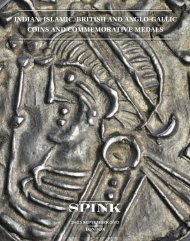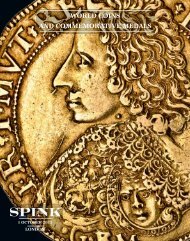bentley priory - Spink
bentley priory - Spink
bentley priory - Spink
You also want an ePaper? Increase the reach of your titles
YUMPU automatically turns print PDFs into web optimized ePapers that Google loves.
THE BENTLEY PRIORY BATTLE OF BRITAIN TRUST APPEAL CHARITY AUCTION<br />
The ones who now set to work on me were prime examples.<br />
They cobbled my face together within the limits of their<br />
dubious skills, which fell far short of those of Dr.<br />
Frankenstein. Then they consigned me to the sick-bay for six<br />
weeks with my jaws wired together.... True to their<br />
reputation, the superannuated surgeons of the air force had<br />
more or less put my face back together back to front. The<br />
sinuses were rendered useless, the nose was flattened and<br />
inoperative. Worst of all, my left eye had floated halfway<br />
down my face, leading to double vision.’ (ibid)<br />
Fighter Command<br />
Fortunately for Kingcome he was subsequently operated on<br />
by Harold Gillies (later Sir Harold) a pioneer of plastic<br />
surgery and by Gillies’ cousin Archie McIndoe (later Sir<br />
Archibald), who was to become the founder of the world<br />
famous Guinea Pig Club at East Grinstead; after six months<br />
of recuperation Kingcome returned to Cranwell; towards the<br />
end of his final term he had to state his preference for<br />
posting, ‘I was already clear in my mind which command I<br />
was going to aim for. I had not joined the R.A.F. to make<br />
myself into a sitting target. If shooting there was to be, then<br />
I was determined that I would be among the shooters, not<br />
one of the shot at... I therefore put Fighter Command down<br />
as first choice, with Coastal Command listed second. Since<br />
there were only five vacancies in Fighter Command that year,<br />
several days of nail biting followed as I waited for the lists to<br />
be posted up. When the list was revealed I found to my deep<br />
content what my new home was going to be: No. 65 Fighter<br />
Squadron at Hornchurch, a front-line fighter station on<br />
London’s eastern rim.’ (ibid)<br />
Kingcome, a newly appointed Pilot Officer, initially flew<br />
Gloster Gladiators with the Squadron, ‘I remained at<br />
Hornchurch from the late summer of 1938 until the Dunkirk<br />
rescue operation in early summer of 1940... The most<br />
significant event at pre-war Hornchurch came about when we<br />
re-equipped from Gladiators to Spitfires, somewhere between<br />
six and nine months before the war began. As one of the first<br />
squadrons to be re-equipped, we gained the huge advantage<br />
that we were already experienced Spitfire pilots by the time<br />
we came to the outbreak of war, and most importantly by the<br />
time of the Dunkirk evacuation. Dunkirk was, indeed, the<br />
first occasion on which the home-based fighters saw any<br />
sustained action.’ (ibid)<br />
Tasked with home defence Kingcome was not sent out with<br />
the BEF, for the battle of France, ‘At Hornchurch the taste<br />
of war at last began to tingle our palates as we anxiously<br />
followed the desperate retreat of the Allied troops as they<br />
were slowly driven into a coastal trap around Dunkirk... My<br />
vantage point for the unfolding epic was in the air above the<br />
beaches... As I sat in the relative safety of my Spitfire cockpit,<br />
it was the clouds that were my main problem. Our orders had<br />
sent us in at 30,000ft, too high for the best of the action,<br />
whereas the Hurricanes were patrolling at 15,000 feet.<br />
Needless to say we cheated and kept slipping down to see<br />
what was happening... the task of providing air cover was<br />
hampered not only by the extent of the cloud cover but also<br />
by its nature. It stood in patchy layers from about 1,000ft<br />
upwards - ideal for marauding bombers but not for our<br />
purposes... allowing little time for interception...<br />
Nevertheless I managed to fire my guns in anger for the first<br />
time, and had the basic fact brought home which I tried to<br />
forget: namely, that while the aircraft in your sites was an<br />
inanimate object, the human beings it contained were frail<br />
flesh and blood. In those early days the German bombers<br />
carried little or no armour, and one of the first indications<br />
that you were registering hits (especially on the Heinkel 111)<br />
came with the spectacle of the guns arching suddenly<br />
upwards as the unfortunate gunners died and slumped<br />
forward on to their weapons.’ (ibid)<br />
On the 2nd June Kingcome shot down two Heinkels and<br />
damaged another over Dunkirk.<br />
92 Squadron - My Squadron<br />
As a result of the rescue operations at Dunkirk 92 Squadron<br />
had lost their CO and two Flight Commanders, ‘Meanwhile<br />
Bob Tuck from 65 Squadron, who was a Flight Commander<br />
by this time, had been further promoted to Squadron Leader<br />
to replace Bushell as CO of 92 Squadron. It was through his<br />
invitation that I now went to fill the gap in leading 92’s A<br />
Flight that had been left by Paddy Byrne. To my mind 92<br />
Squadron always had the special ingredient which sets certain<br />
people or groups apart from the rest - a small, indefinable<br />
quality in the alchemy that gives an edge, a uniqueness. This<br />
quality can never be duplicated or planned for, but somehow<br />
it comes into being and is aptly called ‘spirit’. It always begins<br />
at the top, and 92’s exceptional spirit undoubtedly had its<br />
origins in the outstanding personalities of the original<br />
squadron and flight commanders. It then continued to<br />
flourish in the fertile soil of the rich mix of characters who<br />
made up this exceptional fighting unit: determined,<br />
committed young men, intent on squeezing the last drop of<br />
living from whatever life might be left to them at the same<br />
time as they refused to take themselves or their existence too<br />
seriously.<br />
They came from all walks of life... there was Neville Duke and<br />
‘Wimpy’ Wade, both outstanding airmen who survived the<br />
war with distinguished and much-decorated careers and<br />
became household names as test pilots. There was also Allan<br />
Wright, an ex-Cranwell cadet, extremely bright and<br />
professorial even in those far-off days, but a determined and<br />
successful pilot, and then the youngest of them all Geoff<br />
Wellum, aged 17 and known as ‘Boy’ because of his age. And<br />
there were Don Kingaby and ‘Titch’ Havercroft, two of the<br />
R.A.F.’s most successful NCO pilots, both of whom finished<br />
up as Wing Commanders, Don having a unique distinction in<br />
earning a D.S.O... and three D.F.M.s... Above all, there was<br />
Bob Tuck, extrovert and flamboyant... In the air he was a<br />
total professional, none was more highly respected.’ (ibid)<br />
In June 1940 Kingcome moved with the Squadron to<br />
Llanelli in Wales, for a rest and to look after the West<br />
Country ports and installations; the squadron remained in<br />
South-Wales until the end of August, by which time<br />
Kingcome had another shared destroyed Junkers 88 and one<br />
unconfirmed, ‘early one morning I was out on patrol leading<br />
a section of three of my aircraft from A Flight when we ran<br />
into a lone Junkers 88 on the approach to Cardiff, looking<br />
suspiciously as if it was on a photo-reconnaissance flight. It<br />
was a clear morning without cloud cover, and three Spitfires<br />
coming in on its rear end, the unfortunate German aircraft<br />
never stood a chance. We watched the pilot as he took his<br />
plane down in its terminal dive southwards, pulling up just<br />
before he hit the water and scraping the top of the cliffs on<br />
the north Devon coast, not far from Minehead, before<br />
crashing on to the headland above. He finished up on a fairly<br />
level stretch of scrub and grass, so after we had returned to<br />
base, I climbed into a Magister... and re-crossed the Bristol<br />
Channel to land in the field next to the devastated hulk...<br />
One of the crew still lay where he had died, an enormous<br />
young man... both blond and beautiful. So much of a type<br />
did he seem that I thought at once he must have come<br />
straight off Dr. Goebbel’s drawing board... The recent action<br />
over Dunkirk had borne in on me uncomfortably the human<br />
side of aerial warfare that I preferred to forget, hypocrite that<br />
I was: the signs of German air gunners collapsing over their<br />
weapons as my bullets hit home. Here, on the north Devon<br />
coast, the lesson should have been rubbed in even more<br />
vividly, yet whereas over Dunkirk I had felt genuine remorse<br />
for the lives I was taking and families I was bereaving, here I<br />
felt none.<br />
We had by this stage seen many newsreels of such young men<br />
in action, and here was this perfectly formed young demigod,<br />
apparently personifying all we had gone to war to fight...<br />
faced with this corpse, perhaps I should have brought myself<br />
to feel more Christian, more tolerant, more compassionate, I<br />
could not manage any of these qualities.’ (ibid)<br />
WWW.SPINK.COM

















